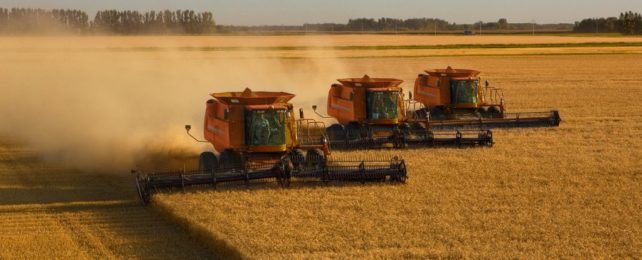The United States is building its future on an eroding foundation.
In the Midwest, one of the world's most productive farming regions, researchers have calculated that current soil erosion is up to a thousand times greater than before modern agriculture's rise.
That's much, much more soil loss than what should be allowed following what the US Department of Agriculture (USDA) says is sustainable in its soil management guidelines.
"For the first time, we know what the natural rates of erosion are in the Midwest," says geologist Caroline Quarrier, who completed the research as part of her master's thesis at the University of Massachusetts (UMass) Amherst.
"And because we now know the rate of erosion before Euro-American settlement, we can see exactly how much modern agriculture has accelerated the process."
The study is based on the presence of a rare element known as beryllium-10, which Quarrier and colleagues detected in the topsoil of 14 native prairies across the US Midwest that have been undisturbed by agriculture.
Beryllium-10 is mostly formed in Earth's atmosphere when cosmic rays from the Milky Way pierce our planet. Once it ends up in the top layer of the soil, its half-life can reveal erosion rates over thousands or even millions of years.
Before modern agriculture, average erosion rates across prairies in Iowa, Minnesota, South Dakota, Nebraska, and Kansas were about 0.04 millimeters a year, Quarrier and colleagues found. That was the case stretching back to the last Ice Age, about 12,000 years ago.
But the situation has changed. Previous measurements from agricultural fields adjacent to the native prairies studied show these cultivated areas are losing topsoil at far greater rates – a thousandfold faster at some sites.
The USDA's current sustainability rules are based on the idea that topsoil in the Midwest can withstand only a millimeter of soil erosion every year.
But this 'baseline' level of erosion, it turns out, is 25 times greater than the average pre-agricultural erosion rates Quarrier and colleagues calculated. In other words, the erosion the USDA considers 'tolerable' for these locations is far, far above natural erosion rates, according to these latest figures.
This is a worry because, at this rate, America's topsoil is simply unable to recover; it's disappearing faster than it can accumulate. As a result, more and more go missing every year.
Earlier in 2022, some of the same researchers at UMass Amherst found that agricultural fields in the Midwest have lost 2 millimeters of soil per year on average since the Euro-American settlement. That's equivalent to about 57.6 billion metric tons of topsoil lost in roughly 160 years.
That's equivalent to about 57.6 billion metric tons of topsoil.
Now that we know from their latest study that natural erosion rates in the Midwest were actually far slower than past estimates, it suggests the consequences of tilling the soil at the rate we are today are even worse than scientists appreciated.
The rapid deterioration of the US Midwest threatens future agricultural production and precious habitats.
In a time of climate crisis, maintaining the health of our planet's topsoil is more crucial than ever.
The world currently grows 95 percent of its food in this top layer of land, and recently the United Nations (UN) warned that if we don't start preserving our planet's soil, the world is on track to suffer biodiversity loss, widespread infrastructure damage, and possibly the displacement of entire human communities.
Soil is also an important way to suck excess carbon out of the atmosphere. Climate change's effects could be even worse without this natural carbon sink.
That's a lot of bad news, but the good news is that it's not too late to take action. Reducing our current erosion rates is possible with the right solutions.
"There are agricultural practices, such as no-till farming, that we know how to do and we know greatly reduce erosion," says Quarrier.
Planting no-till crops is but one example of sustainable farming, however. Better drainage systems can reduce the effects of water erosion while leaving plant cover instead of burning it off at the end of a season can also help topsoil further withstand weathering.
Earlier this year, experts at the UN warned that 90 percent of Earth's topsoil could be at risk of erosion by 2050. Recovering just a few centimeters of that soil under natural conditions will take thousands of years.
America's Midwest isn't the only place that needs to seriously consider changing its ways.
We can't keep going on like this.
The study was published in Geology.
